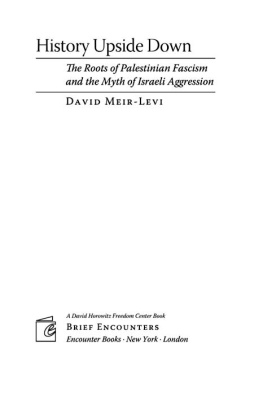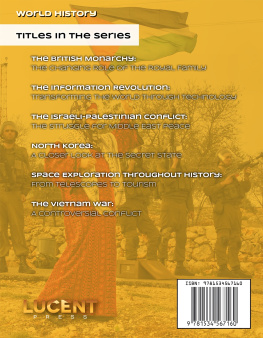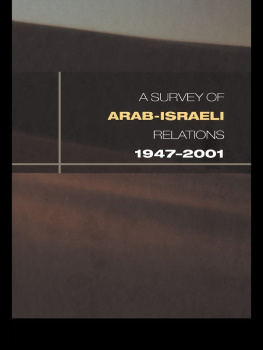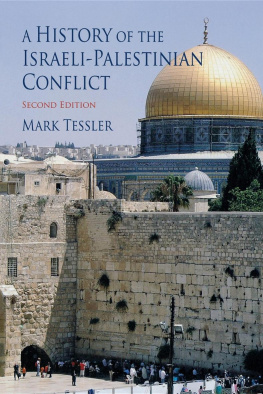



Contents
vii
PART ONE
CHAPTER 1 3
CHAPTER 2 8
CHAPTER 3 6
PART TWO
CHAPTER 4 3
CHAPTER 5 6
CHAPTER 6 7
Introduction
THE BASIC SCRIPT of the Middle East conflict has changed over the last generation, and the version in which it has come to present itself has profoundly distorted the meaning of events and obscured this regional conflict's role in the general war that Islamic radicals have declared against the West.
On its creation by the United Nations in 19 4 8, the state of Israel was attacked by five Muslim Arab nations whose goal, in the words of Hassan al-Banna, founder of the Muslim Brotherhood, was "to push the Jews into the sea." Although outnumbered, the Israelis prevailed. But the Arab states refused to sign a peace, or to create the state that the United Nations had reserved for the Arab population on the west bank of the Jordan and in Gaza. This Arab war against the existence of the Jewish state has been waged for sixty years without let-up.
In 1967, a second aggression by the Arab states, led by the Egyptian dictator Gamal Abdel Nasser, ended with Israel occupying the West Bank and Gaza-the corridors through which the Arab armies had designed their attack. The Israelis were unable to withdraw their forces and maintain their security because their Arab enemies continued refusing to recognize the legitimacy of the Israeli state and to sign a permanent peace agreement.
Until that victory in 19 6 7, the Israeli democracy had been widely seen as the David of the Middle East, menaced by the totalitarian Goliaths of the surrounding Arab states, who wished it dead. But beginning with the Six-Day War and with growing force since then, that perception has changed. Attention has shifted from the aggressors (Egypt, Syria, Jordan, Saudi Arabia, and Iraq) to the Arabs living in the West Bank and Gaza, who began calling themselves "Palestinians" at about the same time that they formed a "national liberation movement." Thus Israel became the Goliath, and the "Palestinians" were now David.
Under Yassir Arafat, this Palestinian movement packaged its cause so adroitly that today it is Israel that is seen as the threatening giant-a heartless occupying power that is colonialist and imperialist, squeezing the life out of a homeless people and denying their national aspirations. So successful has this campaign against Israel been that the Palestinians and their apologists, particularly in Europe, have successfully claimed that the Israelis, a people living in the shadow of the Holocaust, are themselves "Nazis." In demonstrations around the world, the Star of David is routinely shown as equaling the swastika; the faces of Ariel Sharon and other Israeli leaders are morphed into the image of Adolf Hitler.
This book rejects the arrant absurdity of such comparisons (particularly given the fact that every day brings more proof that Iran's Ahmadinejad, Hamas' Nasrallah, and other radical Muslims all yearn for a solution as final as the Nazis'); it also rejects the idea that the basic situation in the Middle East has changed since the United Nations established the Jewish state and the Palestinian state that would have stood alongside it, if not for Arab intransigence. The issue in the Middle East is today what it has been since the Muslim invasion in the seventh century: the Arabs' hatred of the Jews. Jew-hatred goes back to the very beginnings of Islam. So too does genocide, as an end-of-days Armageddon scenario.
Apologists for the Arab world and Muslim culture routinely deny it, but testimony from Muslim refugees and the documentation in books and websites and video documentaries is overwhelming. An essential part of Arab education, from earliest childhood onward, is a dehumanizing hatred for the Jews as the enemies of Islam and of Allah. Jews are depicted as subhuman (based on Qur'an s: 6 0, for example, where Allah likens them to swine and apes) and at the same time as deviously intelligent, using their wiles and machinations for world domination and evil plots against Islam. Not only is everything Jewish evil, but everything evil is Jewish. Hence, as the ancient Hadith of the Tree and the Stone instructs believing Muslims, the Jews, all Jews worldwide, must be destroyed.
It has been but a short step from the religious principle to the political commitment. Part One of this book traces the development of Palestinian nationalism and shows how, building on the Muslim anti-Semitism that has existed in the Middle East for well over a thousand years, that nationalism found soul mates in Nazi fascism and Soviet communismthe one totalitarianism giving the Arab world's inchoate hatred of Jews a systematic intellectual structure; the other showing it how to cloak its genocidal intentions with the mantle of oppression. In helping shape the Palestinian movement, these totalitarian ideologies led directly to the Islamofascism of Hamas.
Instrumental in this grafting was the Grand Mufti of Jerusalem, Haj Amin al-Husseini, unchallenged spiritual leader of the Muslims of British Mandatory Palestine, who begged Hitler to exterminate European Jewry and then do the same to the Jews of Palestine.
But the Nazification of Muslim Jew-hatred continued long after the Third Reich was destroyed. Nazi refugees found haven and employment in Arab countries, where they helped craft the next generation of anti-Jewish and anti-Israel propaganda and educational curricula, all intended to teach the next generation of Muslims that there could be no treaty with Israel, no peace for the Jew.
Communism took Palestinian nationalism to the next step of its development during the Cold War. With the USSR as their ally, and Eastern bloc satellite countries as their haven and training ground, the dozens of Arab terrorist groups that burst out of the Middle East after the Six-Day War learned (some at Patrice Lumumba People's Friendship University in Moscow) to apply Communist techniqueschief among them posturing as a national liberation movement-to their unremitting terror war against Israel.

















